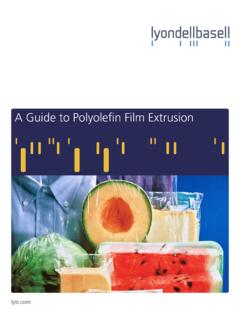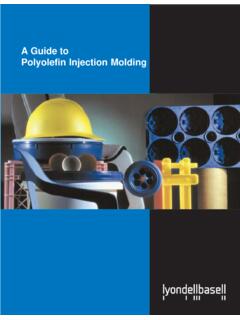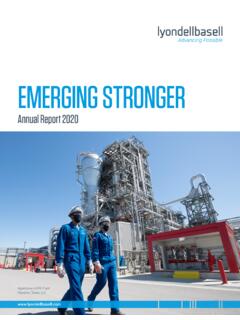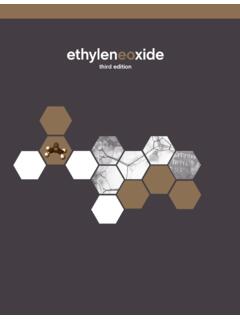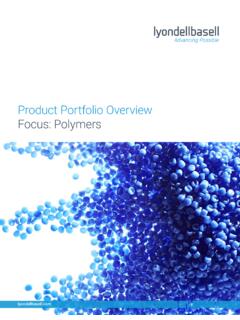Transcription of Technical Data Propylene Carbonate - LyondellBasell
1 Technical data Propylene Carbonate Propylene Carbonate Description Propylene Carbonate (PC) is a VOC-exempt* clear polar solvent having high boiling and flash points, a low order of toxicity and a mild ether-like odor. It is stable under most conditions and is not hydroscopic or corrosive. is particularly well suited for applications requiring a water white product or high purity. Examples would be cosmetics, electronics or where recycling of spent material will occur. Product Identification Chemical Name Chemical Family Other Names Chemical Formula Dioxolanone Organic Carbonate 4-methyl-1 3-dioxolan-2-one C4H6O3 Propylene Carbonate is a cyclic Carbonate that reacts with amines to form carbamates, undergoes hydroxy alkylation and transesterification.
2 It can be used as an isocyanate and unsaturated polyester resin cleanup solvent, viscosity reducer in coatings, CO2 extraction solvent, electrolyte in lithium batteries, polar additive for clay gellants, foundry binder catalyst, and textile dye carrier and cleaner. Typical Properties Autoignition Temperature ( F) 851 Density (pounds per gallon) at 20 C (68 F) Dielectric Constant, csu @ 25 C 64 Distillation @ 760mm, Hg IBP, min. DP, min. 195 C 253 C Evaporation Rate (BuA=1) < Flammability Limits (Lower/Upper Vol. %) Flash Point GT (SETA) F 275 Refractive Index @ 25 C (77 F) Residue on Ignition, wt. %, max. Solubility @ 25 C (% by wt.) PC in water Water in PC 21 8 Specific Gravity @20/20 C Total Hansen Parameter (CGS) Vapor Pressure @ 25 C (77 F) (mmHg) Viscosity (CPS) @ 25 C (77 F) *The Environmental Protection Agency (EPA) has published a rule excluding Propylene Carbonate from the Federal definition of a VOC (40 (s).)
3 State and local definitions may vary. Storage Propylene Carbonate is stable under normal storage conditions. Safety and Handling Undue exposure or spillage should be strictly avoided as a matter of good practice. Hazard ratings are summarized as follows: Health Flammability Reactivity Personal Protection NPCA HMIS 1 1 0 X NFPA 1 1 0 Propylene Carbonate is stable under normal storage conditions. However, in the presence of an acid, base, metal oxide or salt, Propylene Carbonate may decompose liberating CO2. These materials will also decrease thermal stability. In an aqueous solution, the decomposition products would be Propylene glycol and CO2. Either situation could potentially lead to pressure buildup in closed containers, which may result in the container rupturing.
4 It is therefore suggested that all such mixtures be tested for shelf life stability. Material Compatibility Guidelines Carbon steel or stainless steel transfer lines and pumps may be used. Preferred gasket material is Teflon , but EPR, neoprene, plyethylend, cork and natural rubber are satisfactory, Buna N, Hypalon and Viton are not suitable gasket materials. Information from material suppliers and specific conditions of contact should be considered in the selection of suitable materials. Before using a product sold by a company of the LyondellBasell family of companies, users should make their own independent determination that the product is suitable for the intended use and can be used safely and legally.
5 SELLER MAKES NO WARRANTY; EXPRESS OR IMPLIED (INCLUDING ANY WARRANTY OF MERCHANTABILITY OR FITNESS FOR A PARTICULAR PURPOSE OR ANY WARRANTY) OTHER THAN AS SEPARATELY AGREED TO BY THE PARTIES IN A CONTRACT. This product(s) may not be used in: (i) any FDA Class I, Health Canada Class I, and/or European Union Class I medical devices, without prior notification to Seller for each specific product and application; or (ii) the manufacture of any of the following, without prior written approval by Seller for each specific product and application: FDA Class II Medical Devices; Health Canada Class II or Class III Medical Devices; European Union Class II Medical Devices; film, overwrap and/or product packaging that is considered a part or component of one of the aforementioned medical devices.
6 Packaging in direct contact with a pharmaceutical active ingredient and/or dosage form that is intended for inhalation, injection, intravenous, nasal, ophthalmic (eye), digestive, or topical (skin) administration; tobacco related products and applications, electronic cigarettes and similar devices, and pressure pipe or fittings that are considered a part or component of a nuclear reactor. Additionally, the product(s) may not be used in: (i) FDA Class III Medical Devices; Health Canada Class IV Medical Devices; European Class III Medical Devices; (ii) applications involving permanent implantation into the body; (iii) life-sustaining medical applications; and (iv) lead, asbestos or MTBE related applications.
7 All references to FDA, Health Canada, and European Union regulations include another country s equivalent regulatory classification. Users should review the applicable Safety data Sheet before handling the product. Alkylate, Duopac, Duoprime, Filmex, MPDIOL, Polymeg, SAA-100, SAA-101, TBAc, Tebol, T-Hydro, and Tufflo are trademarks owned or used by the LyondellBasell family of companies. Duopac, Duoprime, Filmex, MPDIOL, Polymeg, Tebol, T-Hydro and Tufflo are registered in the Patent and Trademark Office. Houston, Texas, USA l Tel: +1 713 309 7200 or toll-free within USA +1 888 777 0232 Rotterdam, The Netherlands l Tel: +31 10 275 5500 Hong Kong, China l Tel: +852 2882 2668 LyondellBasell Industries Holdings, 2011 2593-V2-0511 Supersedes 2593-V2-0104
